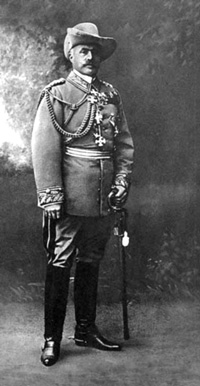World War 1 centenary
Evolution in the Second Reich
New video by Discovery Institute
Introduced in text below by Jonathan Sarfati

This year is the centenary of the beginning of what would become the bloodiest war in history up to that time. Thus at the time, it was called ‘the Great War’. The astronomical cost in life was meant to deter such conflicts again, so it was optimistically called ‘the war to end war’. Because of an even bloodier war starting two decades later, it is now called World War 1.
The origins of the even bloodier war are well known: largely, it was the evolution applied in the Nazi ‘Third Reich’ (1933–1945), as we have documented on our site (see related articles and linked articles). This led to its policies of eugenics, euthanasia, and racial extermination, as well as its plan to eliminate Christianity.
The Nazi predecessor: the Second Reich
However, much less well known is the evolutionary infestation of the Third Reich’s predecessor, the Second Reich. This was Wilhelmine Germany, i.e. Germany under Kaisers Wilhelm I and II, after Otto von Bismarck (1815–1898) unified the country in 1871 from various independent German-speaking states. (The First Reich was the so-called Holy Roman Empire, started either by Charlemagne in AD 800 or Otto 1 in 962, and lasted about 1,000 years until Francis II abdicated in 1806.)
Many of the atrocities of the Third Reich were just consistent and more extreme versions of well-established views taught in the Second Reich. This is what the video clip below documents.

Back in 2010, we had already pointed out the Darwinian connection to World War One. This documented that ideas made infamous by Nazi Germany were being taught in Wilhelmine German academia. These included Lebensraum (‘living space’) and Rassenhygiene (racial hygiene), and the idea that handicapped people were worth less than animals (a belief recently affirmed by Richard Dawkins). War was just an aspect of Darwinian survival of the fittest.
Also, we had pointed out that such horrific ideas resulted in a genuine Holocaust that has been largely forgotten today: the genocide of the Herero people in German South-West Africa (now Namibia). The architect of this mass murder—65,000 of the 80,000 Hereros—Lieutenant-General Lothar von Trotha (1848–1920) was a virulent white supremacist who believed in ‘cleansing’ the allegedly less fit.
WW1 not the end of evolutionary horrors
Unfortunately, even Germany’s defeat in WW1 did not end the problem, for several reasons:
First, Germany never surrendered; instead it was granted a face-saving armistice. So demagogues—such as a disgruntled wounded corporal named Adolf Hitler—could foster the nonsense that they had not really lost, and they were ‘stabbed in the back’.1 By whom? The Jews of course, and other such ‘racially inferior’ groups. This ‘stab-in-the-back myth’ (German: Dolchstoßlegende) is a major reason that the Allies insisted on unconditional surrender in WW2. This was to make it clear to the German people that they really had lost, so would have no choice but to admit the crimes of their government, and submit to Allied denazification measures. Germany has been a model democracy ever since.
Second, it was a Pyrrhic Victory2 for the Allies who had also lost huge numbers of lives. They did not want to repeat such a catastrophe, so adopted disastrous appeasement policies towards Hitler, notably by UK Prime Minister Neville Chamberlain. So instead of stopping Hitler while he was still weak, they emboldened Hitler, resulting in an even bigger disaster than what they were trying to avoid. Many historians regard WW2 as a continuation of WW1 after a 20-year ceasefire.
Third, one of the last acts of the dying Second Reich was to smuggle an exiled Russian Marxist agitator back to Russia, after this agitator had read many of the German anti-Christian philosophers who had inspired Marx. This agitator was Vladimir Ilyich Ulyanov, better known as Lenin (1870–1924). This began the seven-decade–long Soviet Gulag3 State4 that murdered 62 million people in non-war deaths.
Unfortunately, the philosophy behind all these horrors is now the unchallenged religion in the government schools in the Allied countries today. So we link to this outside video as a reminder of what this philosophy can do when applied to national policy. “Explore the influence of Social Darwinism on German militarism in the years leading up to World War I in this fascinating 14-minute documentary featuring historian Richard Weikart.”
References and notes
- The Other complex factors, including aspects of the Treaty of Versailles, as well as the catastrophic hyperinflation of the inter-war Weimar Republic, are not being overlooked. But the issue here is not an analysis of all the reasons for the rise of Hitlerism. Rather, it is to highlight the unbroken line between the evolutionary philosophies that stood behind the German militaristic expansionism and notions of biological superiority common to the background causes of both wars. Return to text.
- From a costly victory of King Pyrrhus of Epirus against the Romans at the battle of Asculum in 279 BC. His army suffered fewer casualties than the Romans, but while the Romans could replenish their armies, Pyrrhus’ losses were irreplaceable. So he famously lamented, “If we are victorious in one more battle with the Romans, we shall be utterly ruined.” Return to text.
- ГУЛАГ (GULAG) was an acronym of Glavnoye Upravleniye Lagerey (Гла́вное управле́ние лагере́й), Main Camp Administration, or in full, Гла́вное управле́ние исправи́тельно-трудовы́х лагере́й и коло́ний (Glavnoye Upravleniye Ispravitel’no-Trudovykh Lagerey i koloniy), The Main Administration of Corrective Labour Camps and Colonies. By metonymy, this original meaning of central administrative agency was transferred to the repressive Soviet system in general, or to the camps and prisons themselves. Return to text.
- A term used by Rudolph Rummel (1932–2014), Professor Emeritus of Political Science at the University of Hawaii, who coined the term democide for murder by government and documented its horrific extent; hawaii.edu/powerkills. Return to text.







Readers’ comments
Comments are automatically closed 14 days after publication.